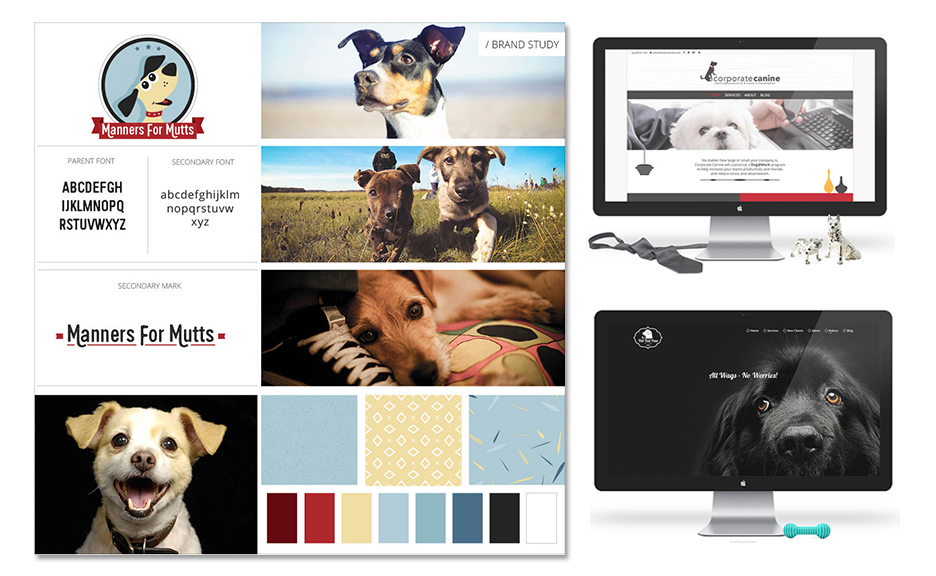
A web design “mood board” and two sample website designs from Sniff Design Studio.
A glossy shopping site gives bored commuters a place to scroll, but pet retailers need to think beyond pretty pictures and consider organization, inbound marketing, shipping costs and refunds.
“Design is only half the job,” says Monica Cevallos, owner and founder of Sniff Design Studio in Eugene, OR, which specializes in e-commerce websites for the pet industry. “Think about all the variables and hidden costs. A good website is an investment, and you are worth it. These are your dreams and your time and your energy — don’t skimp on that.”
Before you start hunting for the right web development team, pick a project manager, design coordinator and a small group of people to give you feedback as the site comes along. Once you’ve got your in-house personnel lined up, start hunting for firm experienced in developing sites from a pet retail perspective.
Advertisement
Points to Consider When Hiring a Web Designer
Organize Your Ideas
Before you dive in, figure out what sets your business apart and map out the homepage, flow and search capabilities relevant to your target market, says Don Tomala, managing partner of the Chicago-based pet products branding firm Matrix Partners. Use descriptive categories and subcategories, and give each page a purpose. “It’s got to be well organized,” Tomala says.
Advertisement
Use Flexible Design
Insist on a web designer with flexible (or “responsive”) design experience. “Seventy-five percent of people are on their phones to browse, and more than half of people buy products on their phones,” says Cevallos of Sniff Design. “Your website needs to be mobile-ready.”
Appear Locally
“Show people you’re open for business by having a local listing,” says John Cullen, principal of Bulldog Marketing and Sales, based in New York City. Fill out Google’s My Business form, which lists your hours, phone number and directions on Google searches and maps. “It’s super important, done by ZIP code, and includes a description of what you’re doing,” Cullen says.
Drive People to the Site
Having a site with no traffic is worse than a store with no marketing. “At least with a store, there’s natural foot traffic,” Cullen says. Drive users to your site by working with a search engine optimization specialist who can sprinkle keywords throughout headlines, title tags, URLs, product descriptions and in the metadata. If you don’t have the cash to invest in SEO, make sure your website is search engine friendly so it can be indexed by Google. “You can also use pay-per-click to drive traffic, but you have to really hire an expert,” Cullen says.
Simplify Sales
A smart designer will help you improve your abandoned cart rates by reducing the number of steps required to shop. Make it possible to buy from your site without logging in, for example, or to duplicate shipping and billing information with a checkbox.
Track Your Progress
Once your site is live, make sure you take full advantage of the powerful tool you have built. Work with a data analyst to track visitor usage. “Is the shopping cart working? How are people buying? How long are they staying?” Cevallos says. The right vendor can also help you use the website’s backend analytics to experiment with paid advertisements, sales funnels and conversion optimization.
What Pet Retailers Say

PHOTO BY victoriasedgwick.com
Julie Foster
PEPELOVES, BOLTON, ENGLAND
“My first step in creating my online pet shop was to decide who my customer was going to be,” says Foster.
”’Pet’ covers such a huge market,” says the business owner. “ You need to decide where you fit within ‘pets.’ Do (your customers) own many pets, only dogs, just cats? Are they savvy shoppers or luxury buyers?”
Foster suggests adding yourself and your pet into the business to create a personal connection with customers. “My Maltese, Pepe, is my chief model and treat-tester,” she says. “We try all the products ourselves and use photos of us both on the website and our social media accounts.”
Foster handled the design, copy and feel of the site for her online pet store, and stressed the importance of recognizing when you need professional website help.
“I built my website to feature luxury pet beds, collars, treats, clothes and toys, but the final task — the complex shipping matrix — was beyond my skills. The pros helped me complete that final step so I could launch.”
This article originally appeared in the March-April 2017 edition of PETS+.